Tips for Mixing High-End Furniture with Accessible Art
 Mixing high-end furniture with accessible art builds rooms that are practical, sharp, and individual. This approach avoids compromise and instead reflects how people actually live.
Mixing high-end furniture with accessible art builds rooms that are practical, sharp, and individual. This approach avoids compromise and instead reflects how people actually live.
Luxury furniture anchors a space with lasting quality and design presence, while accessible art brings flexibility and personal expression. The combination creates interiors that strike a balance between stability and energy, making each room both functional and visually distinct.
Why Mixing High-End Furniture with Accessible Art Works
Pairing high-end furniture with accessible art is as much about atmosphere as aesthetics. This approach creates visual contrast and genuine character.
-
A Solid Foundation
High-end furniture forms a solid, quality foundation in any room. Classic pieces signal strength and stability.
-
Flexible Refreshes
Affordable art makes it easy to refresh a room’s vibe. Just swap pieces to match your mood without spending much.
-
Balance and Warmth
Affordable art balances out luxury pieces, adding warmth and keeping the space from feeling too staged or formal.
-
Long-Term Value
Investing in well-made furniture is worthwhile, as it often holds its value or appreciates over time.
-
Energy and Connection
Surprisingly, accessible art brings energy to shared spaces—bold colors and fresh ideas create vibrancy and invite connection.
-
Genuine Taste
Mixing price points and styles results in rooms that feel considered, not showy, and reflect genuine taste.
-
Personalization and Unity
Blending high with accessible also helps personalize a home, catering to different tastes and needs without sacrificing design unity.
-
Adaptability
The combination supports lifestyle changes—pieces can move, swap, and evolve as routines and preferences shift.
Principles in High-Low Design
Understanding this mix requires a look at the heart of high-low design – a practice that creates spaces with genuine variety and depth.
Layered Contrast
Blend standout investments with approachable accents for a layered, authentic look. “High”-quality furniture—anchors a space with presence and value, while “lows”—affordable art—bring flexibility, relatability, and easier updates.
Built-In Flexibility
Abstract wall art adapts with trends and keeps rooms fresh without big costs. Rotating art and accents is simpler and more affordable than replacing large pieces of furniture, making change easy.
Depth Through Balance
Mixing quality furniture with simple decor creates depth, brings balance, and makes the space feel warm and unique.
Juxtaposing polished materials with textural or playful art keeps the design interesting.
When executed well, mixing high-end furniture and accessible art isn’t just a look–it’s a livable method. The space adapts as personal style changes, giving each room both a sense of history and the freedom for reinvention. The right balance delivers rooms that are cohesive, functional, and effortlessly unique.
Choosing the Right Accessible Art for Luxury Spaces
Art selection in high-end environments should prioritize style and effect over price. Choosing pieces that align with your design vision results in a more purposeful appearance than decisions driven by cost alone.
Focus on style, not price
Select art that fits your taste, not just your budget. Abstract wall art is flexible—its ambiguity works in layered interiors and adapts as your style changes. This allows for easy updates as trends and preferences shift.
Prioritize scale and proportion
Large furniture needs sizeable art. Small prints get lost above big sofas or beds. Using larger pieces creates impact and balance, ensuring the art complements the furniture rather than disappearing against it.
Balancing Color and Texture
Harmony is more important than being new or different. Select art that matches or intentionally differs from your furniture’s colors and textures. Avoid matching everything exactly. Use different materials—canvas, paper, metal—for variety without clutter.
Abstract patterns can match or differ from rug and sofa colors, establishing either a harmonic look or a planned variation.
Mixing textures adds depth and touchable charm to a room, making it both more inviting and visually appealing.
Layering and Placement Tips
Artists combine layers of texture, material, and scale to shape light, create depth, and bring more energy to their work.
Create Focal Points
One bold piece of abstract art can define a seating area or dining space. Avoid scattering small works; choose one main piece for impact. This draws attention and anchors the room visually.
Mix and Match
Blend frame styles and finishes. Pair your favorite furniture with budget finds, and give simple art a boost with custom framing to make everything feel pulled together.
Styling with Accessories
Accessories bridge the gap between luxury furniture and accessible art. Use trays, books, or vases to connect different elements. Mirrors can double the impact of art. Layer small objects for dimension.
Accessories transition between styles, smoothing the visual leap from designer sofa to accessible print.
Layering objects—ceramics, stones—alongside art adds depth and interest.
Where to Find Accessible Art
For those ready to start experimenting, there are many entry points to sourcing accessible artwork:
-
Hive Artes - Abstract wall art, exclusive designs, museum-quality materials
-
Online galleries - Original pieces at lower prices
-
Social media - Emerging artists, limited releases
Beyond Perfection: Spaces with Personality
Mixing high-end furniture with accessible art builds rooms that are refined and personal. This approach allows for flexibility, regular updates, and a look that stands out without excess. Use quality pieces as anchors, layer in abstract wall art for energy, and let the combination reflect your own style.
Browse by Category

Design Projects
Explore interiors from client work and personal renovations — layered, livable, and always in progress.
read more →
Collaborations
From product launches to styled spaces, discover the brand stories I’ve helped bring to life.
read more →
The Notebook
A growing archive of iconic designers, inspiring artists, and unforgettable design moments.
read more →
Travel by Design
Wander with a designer’s eye — from charming hotels and city guides to visual inspiration abroad.
read more →




